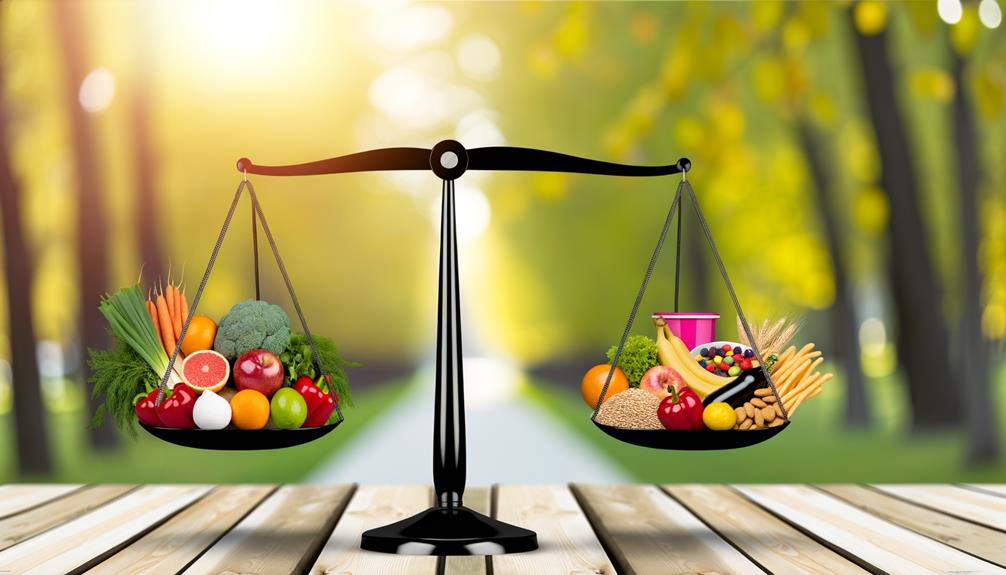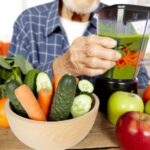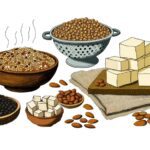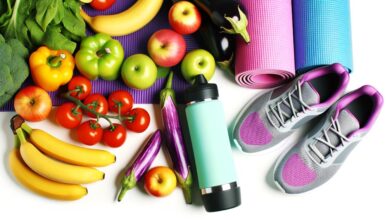Like a trapeze artist walking on a finely balanced wire, you’re embarking on the equally delicate journey of transitioning your diet. You’re not alone in this endeavor, as many globally are embracing dietary changes for a multitude of reasons – be it health, environmental consciousness, ethical beliefs, or cultural practices. It’s crucial to understand how to maintain a nutritional balance during this transition, be it towards a vegan, paleo, ketogenic, or any other dietary lifestyle. You may wonder, how can you ensure you’re getting the right nutrients? How will your body react to these changes? And, most importantly, how can you make this transition sustainable in the long run? All these questions lead us to an intriguing exploration of diet transition and nutritional balance. Let’s embark on this journey, shall we?
Key Takeaways
- Recognize and include sources of essential nutrients in a vegan diet, such as calcium in plant milks and leafy greens, and iron in legumes and fortified cereals.
- Plan the transition to a vegan diet carefully, considering the purpose and timing of the shift, and calculate caloric needs accurately to support a healthy transition.
- Pay attention to balancing nutrient intake by including a variety of foods, such as beans, lentils, tofu, quinoa, fortified plant-based milk, dairy alternatives, whole-grain bread, flaxseeds, chia seeds, and walnuts.
- Stay alert for potential nutritional deficiencies during the diet transition, incorporate nutrient-dense foods, pay attention to portion sizes and meal frequency, and consult a healthcare professional if unsure or experiencing signs of deficiencies.
Understanding Vegan Nutritional Requirements
While transitioning to a vegan lifestyle, it’s critical to understand your nutritional requirements to ensure a balanced diet, particularly when it comes to sourcing protein, balancing macronutrients, and supplementing essential vitamins and minerals. You might need to tweak your eating plan to include nutritious meals that offer a diverse range of fruits and vegetables, whole grains, and healthy fats.
Take time to explore plant-based protein options, like lentils, tofu, and quinoa. They not only provide lean proteins but also contribute to balanced meals. It’s also crucial to recognize sources of essential nutrients in your diet. For instance, calcium can be found in plant milks and leafy greens, while iron is abundant in legumes and fortified cereals.
Understanding vegan nutritional requirements might seem overwhelming at first. But remember, it’s about nurturing a healthier relationship with food. You’re not just avoiding animal products, you’re embracing a lifestyle that’s compassionate and beneficial for your well-being.
Don’t hesitate to consult a registered dietitian who can provide guidance during your transition. They can also help you determine if supplementation for nutrients like vitamin B12 and omega-3 fatty acids is necessary. In this journey, your goal should be to create a balanced, nutrient-rich vegan lifestyle that serves both you and our planet well.
Planning Your Vegan Diet Transition
As you embark on your journey towards a vegan lifestyle, it’s essential to plan your transition carefully, ensuring you understand the purpose and timing of the shift, calculate your caloric needs accurately, and commit to consistent effort even after the transition. This shift in your style of eating can be a significant change, but with a thoughtfully planned meal plan, it’s manageable.
Just like any healthy eating plan, a vegan diet should include a variety of foods to maintain your weight and health. Your meal plan should include a Balanced Meal, containing all necessary nutrients. This includes sourcing proteins from foods like legumes, whole grains, and nuts, ensuring you get adequate vitamins and minerals from fruits and vegetables, and including healthy fats from sources like avocados and seeds.
Tips for Balancing Vegan Nutrient Intake
Now that you’ve got a handle on structuring your vegan meal plan, let’s tackle the crucial task of balancing your nutrient intake. To help you maintain an energy balance, consider your calorie intake and food choices. Including a variety of beans, lentils, tofu, and quinoa can provide you with ample protein.
Gradually increase your portion size of fortified plant-based milk, dairy alternatives, and whole-grain bread to ensure your calcium, vitamin D, and fibre intake are up to par. These foods can also help avoid a caloric deficit, vital for maintaining your strength and metabolic rate.
For those fat-soluble nutrients, don’t forget your omega-3s! Incorporate flaxseeds, chia seeds, and walnuts into your meals. Strength training combined with these nutrient-rich foods can boost your metabolic rate, helping you maintain a healthy weight.
Dealing With Potential Nutritional Deficiencies
When you’re shifting your diet, it’s essential to stay alert for potential nutritional deficiencies that could sneak up on you. You might notice signs like fatigue, weakness, or changes in your skin or hair. It’s integral to maintain a balanced intake of nutrients to keep these issues at bay.
Try to incorporate a variety of nutrient-dense foods in your diet. This strategy not only provides a sufficient number of calories but also ensures the thermic effect of food, which aids in maintaining weight loss. Remember, it’s not just about the calories per serving but the quality of those calories. Avoid foods with added sugars that offer empty calories and no nutritional value.
Developing healthy behaviors around food is key. Pay attention to portion sizes and the frequency of your meals. It’s also crucial to monitor your nutrient intake closely. If you’re unsure, don’t hesitate to consult a healthcare professional. They can assist you in identifying any deficiencies and suggest suitable supplements.
Maintaining Health and Wellness on a Vegan Diet
Shifting gears from general nutrition to specific dietary choices, let’s explore how you can maintain optimal health and wellness on a vegan diet. Adopting sustainable habits is vital to maintaining nutritional balance during your diet transition. Here’s a brief guide:
- Gradually increase your intake of plant-based meals, balancing comfort foods with nutrient-rich alternatives.
- Keep your energy intake high with a variety of fruits, vegetables, whole grains, legumes, nuts, and seeds.
- Be cautious of processed foods; instead, opt for fresh, whole foods to ensure a wholesome diet.
It’s important to remain active too, because physical activity goes hand-in-hand with a balanced diet. This combination reduces the risk of cardiovascular diseases and eating disorders. Remember, there’s no ‘one-size-fits-all’ approach. Your healthcare provider or a dietitian can be instrumental in personalizing your vegan meal plan, ensuring you get enough protein, iron, calcium, vitamin D, and vitamin B12.
Frequently Asked Questions
What Should You Do to Maintain a Balance Diet and Nutrition?
You should monitor your calorie intake, practice portion control, and maintain balanced snacking. Using food diaries can help. Don’t forget nutritional supplements, regular exercise, and drinking water. Prioritize food quality in meal planning, even in a vegan transition.
What Is the Nutrition Transition Diet?
The nutrition transition diet refers to your shift in dietary patterns due to socioeconomic factors, blending traditional and modern diets. It’s essential to understand the health implications, influenced by physical activity and food availability.
How Do You Transition From Diet to Maintenance?
You’ll face transition challenges, but remember, slow and steady wins the race. Use maintenance strategies like calorie adjustment, portion control, and mindful eating. Make sustainable choices, form new habits, and combine regular exercise with regular check-ups.
What Is an Example of a Nutrition Transition?
An example of a nutrition transition could be shifting from a traditional, locally-sourced diet to a Westernized diet due to economic factors, cultural influences, and increased food availability, which can have significant health implications.







